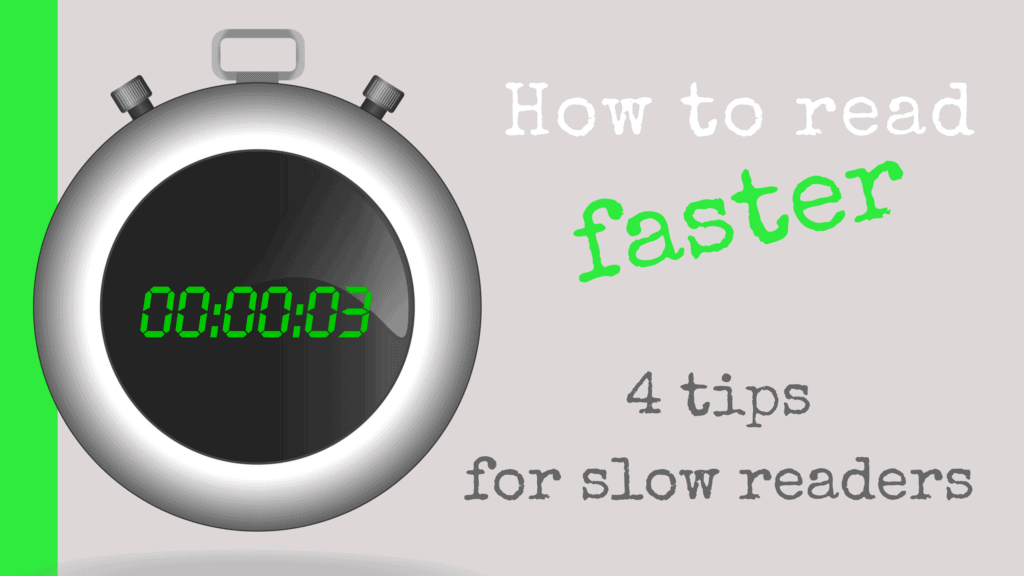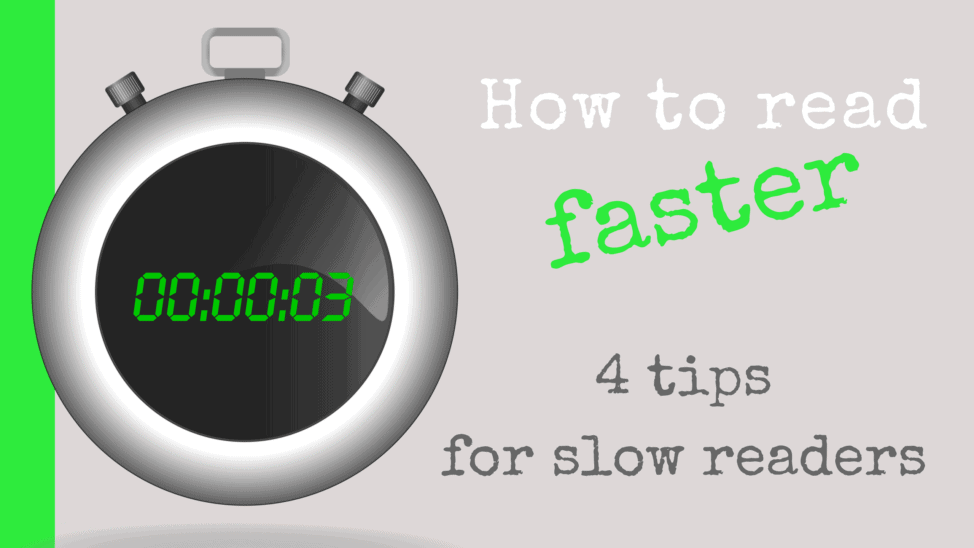
Are you a slow reader? If so, how do you know? Did someone once tell you that you were a slow reader, or do you just feel like you’re reading slowly? Also — does it even really matter that you read slowly?
If you are a legitimate slow reader and you know for sure that your reading pace is not what it should be, there are a gazillion “speed reading” programs out there that claim to teach you how to read faster. Some of these programs may work (a little), and some are complete bologna. (Here’s some more info on speed reading theory if you’re interested.) The ones that may work (a little) are those that teach readers how to eliminate the subvocalization (inner voice) that slows down the reading process. It’s not easy to eliminate subvocalization, but that’s the theory.
The reading tips I’m sharing here are not intended to reduce subvocalization. Instead, the tips are simple strategies and hacks that can help you read a little quicker and make the process a bit easier — and can be effective immediately (instead of paying $499 for a 10-week program that involves 6 hours of reading practice a day … yeah… seriously?!).
How to read faster: 4 tips for slow readers
1. Listen to the audio book or YouTube audio
Wait – how is listening to the audio version of a book even reading?! You’re right. It’s not reading. But whether you listen to the book or read the book with your own eyeballs, the purpose is the same: to understand the content and learn something about something. Listening is not cheating! There are YouTube videos of random people reading many popular books — or you can get an audio book from the library or from a subscription service like audible. There are ways and there are ways — and they all work. For some of us, the trick for how to read faster is simply to listen.
2. Read a chapter summary or outline first.
Am I really promoting SparkNotes here? Maybe. (Shh.) But what I mean by this slow-reader tip is that knowing what you’re getting yourself into can make “getting into it” quicker and smoother. While slow readers may read slowly for different reasons, many readers read slowly because they have to keep re-reading parts of the text that confused them before moving on. Doing this totally slows you down. If you’re reading a novel, reading through a brief chapter summary first can prime you (prepare you) for what you’re about to read, so you’re less likely to get hung up on the details and feel the need to go back and read every paragraph twice. Know what I mean?
I know what you’re thinking: How does reading a chapter summary SAVE me time? Doesn’t that take up MORE time? No, it does not. The amount of time you’ll save by not having to re-read the whole chapter twice will be more than enough to offset the time it takes you to read the short summary in advance.
Also – I’m not saying that SparkNotes summaries can replace the actual reading. Nonsense. Read the summary first, and then do the reading yourself.
If you’re reading a textbook, then look at the beginning and end of each chapter for the outline and summary information.
3. Let go of some details and focus on the gist.
Depending on what you’re reading and why you’re reading it, you may not need to catch, understand and remember every single detail of what you’re reading. I like to think of the 80-20 rule here: if you understand 80% of what you read and let the remaining 20% go, you will be okay most of the time. What’s difficult for many students is letting go of thoughts of I need to understand everything completely before moving on! Not so. If you read a paragraph or a page and you feel mostly comfortable with your comprehension, then keep reading and don’t look back. But of course, if you read the whole page and can’t remember a darn thing you read, then read these tips first and then go re-read the page.
4. Get rid of distractions.
I know, I know. This tip seems lame and overdone. But FOR REAL – it’s important. Even speed readers will read slowly and inefficiently if they’re looking at their phones every two seconds or paying attention to the conversation next to them or listening to the TV in the background. Silence, people! Really – when you sit down to read something, pick a quiet environment, put the phone/whatever distracting thing away, and focus strictly on what you’re reading. If you struggle with focusing for long periods of time without distractions, then plan your distractions using the Pomodoro Technique. And when you’re done figuring out what that technique is, here are more tips for staying focused while reading.
Despite popular myth, our brains cannot multitask (no, you cannot read a paragraph and listen to your friend talk at the same time), so focus on one thing (reading!) at a time.
Learning how to read faster is not a matter of magical programs and revolutionary techniques that will rock your reading world. Sure, you will increase your reading speed if you read for 6 hours a day, but who has time for that?! The 4 tips above are practical, they work, and they are — if you really think about it — common sense!

